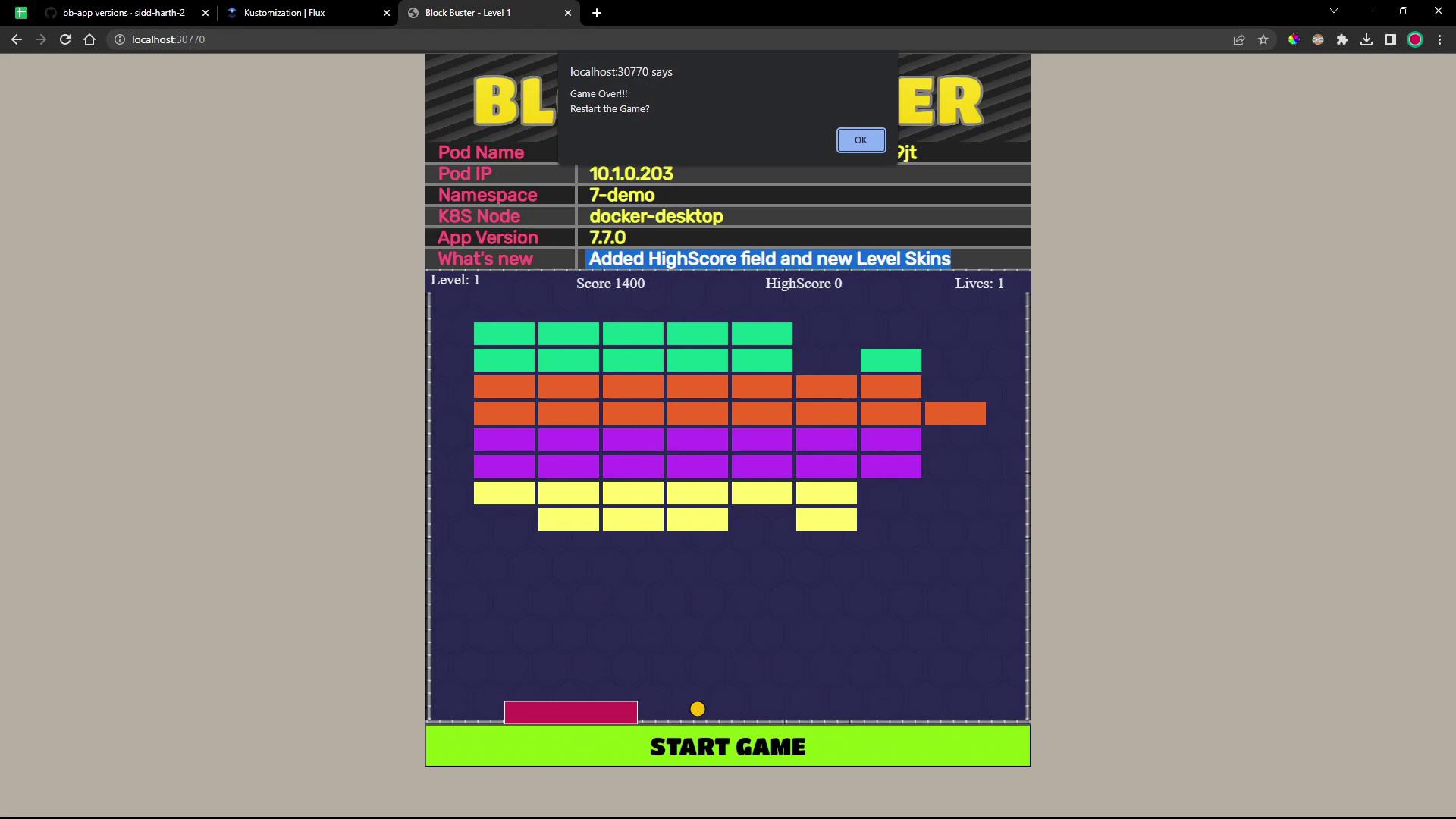GitOps with FluxCD
Helm Controller and OCI Registry
DEMO Flux Pull and Deploy from OCI Registry
In this tutorial, you’ll learn how to use the Flux Source Controller to fetch container images from an OCI-compatible registry (GitHub Container Registry) and deploy them to your Kubernetes cluster. We’ll pull the bb-app image (7.7.0-0bb2691) from GHCR, configure authentication, and create a Kustomization to manage deployments.
Prerequisites
- A Kubernetes cluster with Flux CD installed (Flux Installation Guide).
fluxCLI andkubectlconfigured to target your cluster.- Docker (optional) to verify the image locally.
Overview of Flux Resources
| Resource Type | Purpose | Flux Command Example |
|---|---|---|
| OCIRepository | Registers an OCI image as a Flux source | flux create source oci demo-source-oci-bb-app --url oci://ghcr.io/... |
| Secret (OCI) | Stores registry credentials | flux create secret oci ghcr-auth --url ghcr.io --username USER --password TOKEN |
| Kustomization | Pulls and applies manifests or images | flux create kustomization demo-kustomize-bb-app --source OCIRepository/demo-source-oci-bb-app --target-namespace bb-app |
1. Pull the OCI Image Locally (Optional)
Verify the bb-app image before integrating with Flux:
docker pull ghcr.io/sidd-harth-2/bb-app:7.7.0-0bb2691
You need both the image path (ghcr.io/sidd-harth-2/bb-app) and the tag (7.7.0-0bb2691).
Note
Public OCI registries (e.g., Docker Hub) typically don’t require authentication. Private registries like GHCR do.
2. Create an OCIRepository Source
Register the image in Flux by creating an OCIRepository. Update the tag to 7.7.0-0bb2691:
cd block-buster/flux-clusters/dev-cluster
flux create source oci demo-source-oci-bb-app \
--url oci://ghcr.io/sidd-harth-2/bb-app \
--tag 7.7.0-0bb2691 \
--secret-ref ghcr-auth \
--provider generic \
--interval 1m \
--export > demo-source-oci-bb-app.yaml
Contents of demo-source-oci-bb-app.yaml:
apiVersion: source.toolkit.fluxcd.io/v1beta2
kind: OCIRepository
metadata:
name: demo-source-oci-bb-app
namespace: flux-system
spec:
interval: 1m0s
provider: generic
url: oci://ghcr.io/sidd-harth-2/bb-app
ref:
tag: 7.7.0-0bb2691
secretRef:
name: ghcr-auth
3. Create the OCI Authentication Secret
Flux requires credentials to pull from a private registry. Generate a GitHub Personal Access Token (PAT) with the read:packages scope, then create the secret:
flux create secret oci ghcr-auth \
--url ghcr.io \
--username sidd-harth-2 \
--password <GITHUB_PERSONAL_ACCESS_TOKEN> \
--export > ghcr-auth.yaml
Warning
Keep your GitHub PAT secure. Do not commit ghcr-auth.yaml to public repositories.
Apply both manifests:
kubectl apply -f ghcr-auth.yaml
kubectl apply -f demo-source-oci-bb-app.yaml
Verify the secret in the flux-system namespace:
kubectl -n flux-system get secrets
# NAME TYPE DATA AGE
# flux-system Opaque 3 17h
# ghcr-auth kubernetes.io/dockerconfigjson 1 10s
4. Create a Kustomization for Deployment
Define a Kustomization that references your OCIRepository, sets up health checks, and enforces dependency ordering:
flux create kustomization demo-kustomize-bb-app \
--source OCIRepository/demo-source-oci-bb-app \
--target-namespace bb-app \
--interval 10s \
--prune false \
--timeout 2m \
--depends-on infra-database-git-mysql \
--health-check 'Deployment/block-buster-7-7-0' \
--export > demo-kustomize-bb-app.yaml
demo-kustomize-bb-app.yaml:
apiVersion: kustomize.toolkit.fluxcd.io/v1beta2
kind: Kustomization
metadata:
name: demo-kustomize-bb-app
namespace: flux-system
spec:
interval: 10s
timeout: 2m0s
prune: false
dependsOn:
- name: infra-database-git-mysql
healthChecks:
- apiVersion: apps/v1
kind: Deployment
name: block-buster-7-7-0
namespace: bb-app
sourceRef:
kind: OCIRepository
name: demo-source-oci-bb-app
namespace: flux-system
targetNamespace: bb-app
Apply the Kustomization:
kubectl apply -f demo-kustomize-bb-app.yaml
Health Checks
Flux polls the specified resource and waits until it’s ready before marking the Kustomization as healthy. Example for a Git-based Kustomization:
apiVersion: kustomize.toolkit.fluxcd.io/v1
kind: Kustomization
metadata:
name: backend
namespace: default
spec:
sourceRef:
kind: GitRepository
name: webapp
healthChecks:
- apiVersion: apps/v1
kind: Deployment
name: backend
namespace: dev
Dependencies
The dependsOn field enforces deployment order. In this demo, bb-app waits for infra-database-git-mysql (your SQL database) to succeed first.
5. Reconcile and Debug
Check the Kustomization status:
flux get kustomizations
If reconciliation stalls or health checks time out, inspect the resource:
kubectl -n flux-system get kustomizations.kustomize.toolkit.fluxcd.io demo-kustomize-bb-app -o yaml
Correct any mismatches (e.g., deployment names), then trigger a manual reconcile:
flux reconcile kustomization demo-kustomize-bb-app
Verify the deployment reaches Ready:
flux get kustomizations
# NAME READY MESSAGE
# demo-kustomize-bb-app True Applied revision: 7.7.0-0bb2691@sha256:...
6. Verify the Deployment
List all resources in the bb-app namespace:
kubectl -n bb-app get all
# NAME STATUS AGE
# pod/block-buster-7-7-0-768744659-879jt Running 2m
# service/block-buster-service-7-7-0 NodePort 10.105.73.12 80:3770/TCP 2m
# deployment.apps/block-buster-7-7-0 1/1 2m
# replicaset.apps/block-buster-7-7-0-768744659 1/1 2m
Then open your browser at http://127.0.0.1:3770. In version 7.7.0 you’ll notice a new “High Score” field—but a known bug prevents high scores from persisting:

That issue will be fixed in the next release. Thanks for following along!
References
Watch Video
Watch video content